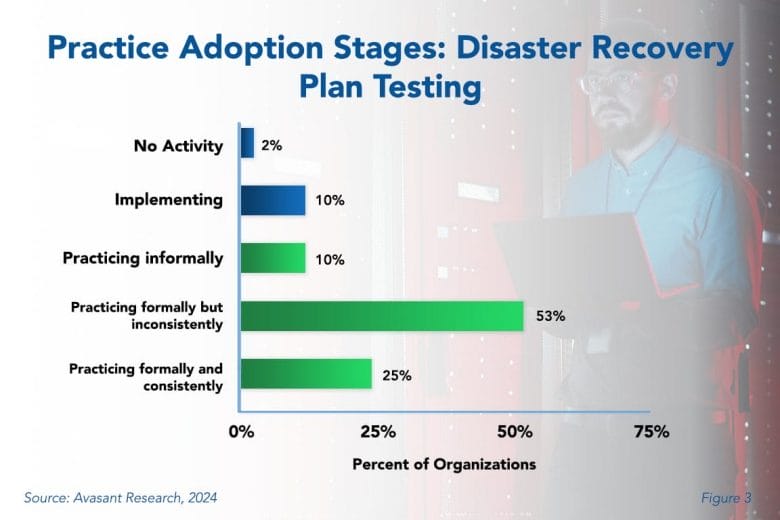In today’s unpredictable business environment, there is an increasing reliance on data and digital systems to operate efficiently. With this comes the need for robust disaster recovery (DR) plans and testing to reduce the impact of unforeseen events. The effectiveness of a DR plan can only be truly validated through routine testing. However, while this practice is growing, few organizations are testing their DR plans formally and consistently.
Formal and consistent DR testing implies that the procedure is documented, reviewed, and executed often to ensure thorough restoration of services. As shown in Figure 3 from our full report, Disaster Recovery Planning Best Practices, only 25% of organizations practice DR plan testing formally and consistently. Meanwhile, a significant 53% practice it formally but inconsistently.

Consistent disaster recovery plan testing is essential to business continuity, especially when the IT systems of an enterprise are constantly changing. Even if a disaster recovery plan is formally documented, it will become ineffective when changes are introduced into an organization’s IT systems. Regular testing ensures the plan is frequently reviewed and revised as systems or infrastructure change. In addition to ensuring that the disaster recovery plan is effective and helping reveal its weaknesses, testing is also required for compliance and regulation adherence. This is critical for many industries subject to strict regulatory requirements regarding data protection and business continuity.
“The problem isn’t that IT leaders don’t see the importance of disaster recovery plan testing,” said Waynelle John, research analyst for Avasant Research based in Los Angeles. “But most businesses aren’t doing the things that are necessary to maintain formal and consistent DR plan testing. Don’t let your disaster recovery plan gather dust!”
Disaster recovery plan testing ensures that an organization can recover its data and applications, allowing seamless resumption of operations following service interruptions, critical IT failures, or other major disruptions. Its purposes include determining the capability of recovery processes, identifying deficiencies, training personnel, and providing a structure for updating the disaster recovery plan. Numerous instances show that the business impact of a disaster affecting the IT function can be enormous. The ability to recover information systems and data after a disaster or system failure should be an organizational priority to mitigate the potential for significant disruption and financial loss.
In the full study, we first look at adoption trends for disaster recovery plan testing by organization size and sector. The responses enable us to determine how widely a discipline has been adopted, how formally and consistently it is being practiced, and how quickly it is likely to grow. We also discuss the elements every disaster recovery plan test should contain, and the steps IT organizations can take to establish such testing effectively.
This Research Byte is a brief overview of our study, Disaster Recovery Plan Testing Best Practices. The full report is available at no charge for subscribers, or it may be purchased by non-clients directly from our website (click for pricing).

